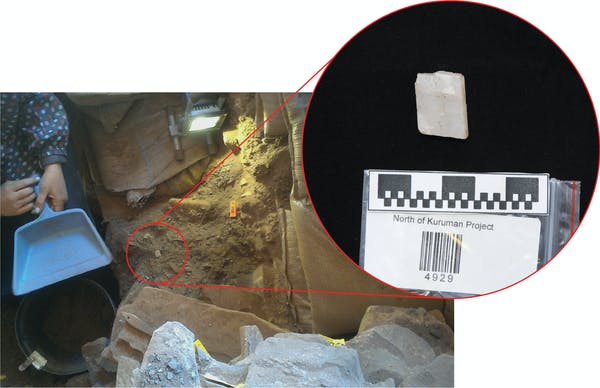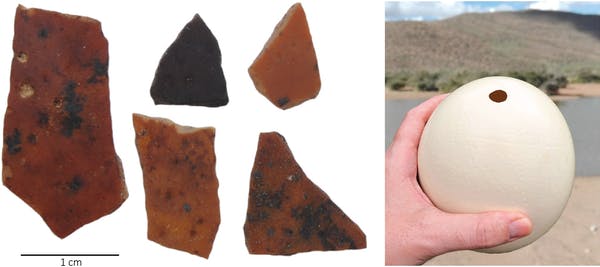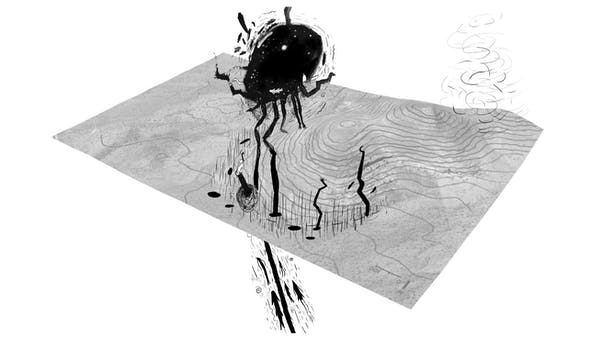Science
Someone in The Kalahari Collected Crystals a Whopping 105,000 Years Ago – ScienceAlert

A rockshelter in South Africa’s Kalahari documents the innovative behaviors of early humans who lived there 105,000 years ago. We report the new evidence today in Nature.
The rockshelter site is at Ga-Mohana Hill – a striking feature that stands proudly above an expansive savanna landscape.
Many residents of nearby towns consider Ga-Mohana a spiritual place, linked to stories of a great water snake. Some community members use the area for prayer and ritual. The hill is associated with mystery, fear and secrecy.
Now, our findings reveal how important this place was even 105,000 years ago, documenting a long history of its spiritual significance. Our research also challenges a dominant narrative that the Kalahari region is peripheral in debates on the origins of humans.
We know our species, Homo sapiens, first emerged in Africa. Evidence for the complex behaviours that define us has mostly been found at coastal sites in South Africa, supporting the idea that our origins were linked to coastal resources.
This view now requires revision.
(Author provided)
Above: The Ga-Mohana Hill North Rockshelter is located near the town of Kuruman in the Northern Cape province of South Africa.
A crystal-clear finding
We found 22 white and well-formed calcite crystals brought to the site 105,000 years ago. We determined this using a method called “optically stimulated luminescence”, which dates sediments the crystals were excavated from.
Our analysis indicates the crystals were not introduced into the deposits via natural processes, but rather represent a small cache of deliberately collected objects.
Crystals found across the planet and from several time periods have previously been linked to humans’ spiritual belief and ritual. This includes in southern Africa.
People at coastal sites similarity started to collect non-food seashells around the same time (but not earlier) – perhaps for similar reasons.


One of 22 calcite crystals excavated from 105,000-year-old deposits. (Author provided)
Egg-citing technology
Ostrich eggshells can make excellent water storage containers and were used as such in southern Africa during the Pleistocene and Holocene. At coastal sites, the earliest evidence for this technology dates back about 105,000 years.
At Ga-Mohana Hill, we found ostrich eggshell fragments that show all the signs of being human-collected, based on their strong association with artefacts (including animal bones that are cut-marked from being butchered), and evidence of having been burned. These fragments may be the remains of early containers.


Above: 105,000-year-old ostrich eggshell fragments (left). Modern day example of ostrich eggshell canteen (right).
This suggests early humans in the Kalahari were no less innovative than those living on the coast.
A global effort
International and interdisciplinary collaboration makes for the best research and our paper’s authorship includes researchers from eight institutions across Australia, South Africa, Canada, Austria and the UK.
Local South African collaborators had an especially crucial role. For example, Robyn Pickering, Jessica von der Meden and Wendy Khumalo at the University of Cape Town provided important palaeoenvironmental context for the archaeology.
By dating tufa deposits around Ga-Mohana Hill, they showed water was more abundant 105,000 years ago when early humans were using the rockshelter.
Nnoga ya metsi
Many who visit Ga-Mohana Hill today for ritual practice see it as part of a network of places linked to the Great Water Snake (Nnoga ya metsi), a capricious and shape-shifting being. Many of these spiritual places are also associated with water.
Places such as Ga-Mohana Hill and their associated stories remain some of the most enduring intangible cultural artefacts from the past, linking modern indigenous South Africans to earlier communities.
These enduring beliefs establish an important sense of orientation in a country that has been spatially disorientated by colonial disruption.


Respectful research benefits all
Those who visit the site today for ritual purposes rely on its association with fear to launch them into their desired ritual states. The site’s remoteness greatly contributes to this.
Recognising this significance, we’ve been adjusting our project methods to not undermine the practices held there. For example, following each excavation season, the areas we work from are completely back-filled and covered with sediment.
In this way, we can carefully recover our sections later, but leave almost no visible trace of our work. We haven’t erected any signage or structures, or otherwise left any significant permanent modifications.
Community engagement continues as we consider ways to integrate the cultural and archaeological values of Ga-Mohana Hill. We are working to further develop an approach that has a positive impact on local communities, while also reflecting on what these communities teach us – particularly regarding respect and ritual.
From an archaeological perspective, we believe this approach will help ensure Ga-Mohana Hill can continue to offer new and valuable insights into the evolution of Homo sapiens in the Kalahari. ![]()
![]()
Jayne Wilkins, ARC DECRA Research Fellow, Griffith University and Sechaba Maape, Senior Lecturer, University of the Witwatersrand.
This article is republished from The Conversation under a Creative Commons license. Read the original article.
Science
Giant prehistoric salmon had tusk-like teeth for defence, building nests: study – CP24


Brenna Owen, The Canadian Press
Published Wednesday, April 24, 2024 7:27PM EDT
Last Updated Wednesday, April 24, 2024 7:27PM EDT
The artwork and publicity materials showcasing a giant salmon that lived five million years ago were ready to go to promote a new exhibit, when the discovery of two fossilized skulls immediately changed what researchers knew about the fish.
Initial fossil discoveries of the 2.7-metre-long salmon in Oregon in the 1970s were incomplete and had led researchers to mistakenly suggest the fish had fang-like teeth.
It was dubbed the “sabre-toothed salmon” and became a kind of mascot for the Museum of Natural and Cultural History at the University of Oregon, says researcher Edward Davis.
But then came discovery of two skulls in 2014.
Davis, a member of the team that found the skulls, says it wasn’t until they got back to the lab that he realized the significance of the discovery that has led to the renaming of the fish in a new, peer-reviewed study.
“There were these two skulls staring at me with sideways teeth,” says Davis, an associate professor in the department of earth sciences at the university.
In that position, the tusk-like teeth could not have been used for biting, he says.
“That was definitely a surprising moment,” says Davis, who serves as director of the Condon Fossil Collection at the university’s Museum of Natural and Cultural History.
“I realized that all of the artwork and all of the publicity materials and bumper stickers and buttons and T-shirts we had just made two months prior, for the new exhibit, were all out of date,” he says with a laugh.
Davis is co-author of the new study in the journal PLOS One, which renames the giant fish the “spike-toothed salmon.”
It says the salmon used the tusk-like spikes for building nests to spawn, and as defence mechanisms against predators and other salmon.
The salmon lived about five million years ago at a time when Earth was transitioning from warmer to relatively cooler conditions, Davis says.
It’s hard to know exactly why the relatives of today’s sockeye went extinct, but Davis says the cooler conditions would have affected the productivity of the Pacific Ocean and the amount of rain feeding rivers that served as their spawning areas.
Another co-author, Brian Sidlauskas, says a fish the size of the spike-toothed salmon must have been targeted by predators such as killer whales or sharks.
“I like to think … it’s almost like a sledgehammer, these salmon swinging their head back and forth in order to fend off things that might want to feast on them,” he says.
Sidlauskas says analysis by the lead author of the paper, Kerin Claeson, found both male and female salmon had the “multi-functional” spike-tooth feature.
“That’s part of our reason for hypothesizing that this tooth is multi-functional … It could easily be for digging out nests,” he says.
“Think about how big the (nest) would have to be for an animal of this size, and then carving it out in what’s probably pretty shallow water; and so having an extra digging tool attached to your head could be really useful.”
Sidlauskas says the giant salmon help researchers understand the boundaries of what’s possible with the evolution of salmon, but they also capture the human imagination and a sense of wonder about what’s possible on Earth.
“I think it helps us value a little more what we do still have, or I hope that it does. That animal is no longer with us, but it is a product of the same biosphere that sustains us.”
This report by The Canadian Press was first published April 24, 2024.
Science
Nasa's Hubble marks 34th anniversary with stunning view of Little Dumbbell Nebula – The Times of India


In celebration of its 34th anniversary, Nasa‘s Hubble Space Telescope has once again wowed astronomers and space enthusiasts alike by capturing an extraordinary image of the Little Dumbbell Nebula. This latest image offers a vivid glimpse into the complexities of a planetary nebula, demonstrating Hubble’s enduring capabilities in its extended mission.
The Little Dumbbell Nebula, also known as Messier 76, is one of the faintest objects in the Messier catalog and has intrigued astronomers for its intricate structure and dual-lobed shape. This planetary nebula, located approximately 2,500 light-years away in the constellation Perseus, represents a brief stage in the life cycle of a moderate-sized star like our sun.
Dr. Jennifer Wiseman, a senior scientist at Nasa’s Goddard Space Flight Center, expressed her admiration for the new imagery: “This beautiful nebula is what remains after a star like our own sun has exhausted the bulk of its nuclear fuel and shed its outer layers. The vibrant colors and intricate structures visible in the nebula are a telescope’s way of painting the portrait of the final stages of stellar evolution.”
The Little Dumbbell Nebula, despite its faintness, shines brightly in the detailed images provided by Hubble, allowing scientists to study aspects of the nebula that are rarely visible. The images highlight the dense, glowing gas and complex layers of material expelled from the dying star at the center of the nebula.
According to Dr. Wiseman, “Hubble’s high-resolution capabilities allow us to examine the fine details within the nebula, helping us understand how stars expel their material and the dynamics of this expulsion process. This image is more than just a picture; it’s a deep dive into the life of stars.”
Since its launch on April 24, 1990, Hubble has revolutionized our understanding of the universe, from the dynamics of galaxies to the atmospheres of exoplanets and the distribution of dark matter. Its contributions continue to support and complement data gathered by newer space observatories.
As Hubble continues its journey in space, the scientific community remains enthusiastic about the ongoing contributions it will bring to our understanding of the cosmos. Dr. Wiseman remarked, “Every image from Hubble is a new lesson in our cosmic curriculum.”
These observations not only contribute significantly to our knowledge of the life cycle of stars but also continue to highlight the critical role of Hubble in the exploration and understanding of our universe. As Hubble enters another year in orbit, its legacy of discoveries promises to keep inspiring both the scientific community and the public.
Science
SpaceX launch marks 300th successful booster landing – Phys.org


SpaceX sent up the 30th launch from the Space Coast for the year on the evening of April 23, a mission that also featured the company’s 300th successful booster recovery.
A Falcon 9 rocket carrying 23 of SpaceX’s Starlink internet satellites blasted off at 6:17 p.m. Eastern time from Cape Canaveral Space Force Station’s Space Launch Complex 40.
The first-stage booster set a milestone of the 300th time a Falcon 9 or Falcon Heavy booster made a successful recovery landing, and the 270th time SpaceX has reflown a booster.
This particular booster made its ninth trip to space, a resume that includes one human spaceflight, Crew-6. It made its latest recovery landing downrange on the droneship Just Read the Instructions in the Atlantic Ocean.
The company’s first successful booster recovery came in December 2015, and it has not had a failed booster landing since February 2021.
The current record holder for flights flew 11 days ago making its 20th trip off the launch pad.
SpaceX has been responsible for all but two of the launches this year from either Kennedy Space Center or Cape Canaveral with United Launch Alliance having launched the other two.
SpaceX could knock out more launches before the end of the month, putting the Space Coast on pace to hit more than 90 by the end of the year, but the rate of launches by SpaceX is also set to pick up for the remainder of the year with some turnaround times at the Cape’s SLC-40 coming in less than three days.
That could amp up frequency so the Space Coast could surpass 100 launches before the end of the year, with the majority coming from SpaceX. It hosted 72 launches in 2023.
More launches from ULA are on tap as well, though, including the May 6 launch atop an Atlas V rocket of the Boeing CST-100 Starliner with a pair of NASA astronauts to the International Space Station.
ULA is also preparing for the second launch ever of its new Vulcan Centaur rocket, which recently received its second Blue Origin BE-4 engine and is just waiting on the payload, Sierra Space’s Dream Chaser spacecraft, to make its way to the Space Coast.
Blue Origin has its own rocket it wants to launch this year as well, with New Glenn making its debut as early as September, according to SLD 45’s range manifest.
2024 Orlando Sentinel. Distributed by Tribune Content Agency, LLC.
Citation:
SpaceX launch marks 300th successful booster landing (2024, April 24)
retrieved 24 April 2024
from https://phys.org/news/2024-04-spacex-300th-successful-booster.html
This document is subject to copyright. Apart from any fair dealing for the purpose of private study or research, no
part may be reproduced without the written permission. The content is provided for information purposes only.
-



 Politics23 hours ago
Politics23 hours agoOpinion: Fear the politicization of pensions, no matter the politician
-



 Science22 hours ago
Science22 hours agoNASA Celebrates As 1977’s Voyager 1 Phones Home At Last
-



 Politics22 hours ago
Politics22 hours agoPecker’s Trump Trial Testimony Is a Lesson in Power Politics
-
Business21 hours ago
Oil Firms Doubtful Trans Mountain Pipeline Will Start Full Service by May 1st
-
Media15 hours ago
B.C. online harms bill on hold after deal with social media firms
-
Media22 hours ago
B.C. puts online harms bill on hold after agreement with social media companies
-
Media21 hours ago
Trump poised to clinch US$1.3-billion social media company stock award
-
Art24 hours ago
Turner Prize: Shortlisted artist showcases Scottish Sikh community






